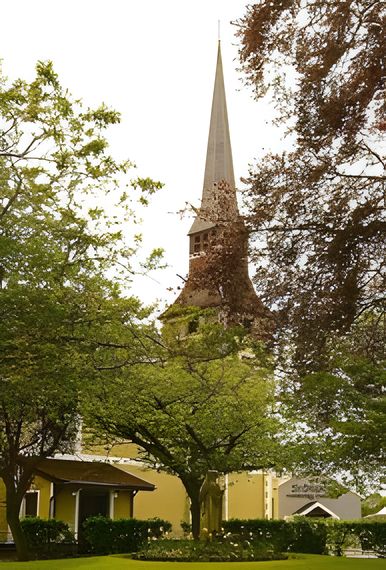After the reformation the Catholic Church slowly built a new parish organisation. The new Catholic parishes were generally amalgamations of a number of older medieval parishes; Blanchardstown was one such new parish.
It covered an area from the Salmon Pool near Island Bridge, along the Liffey to Shackleton’s Mills at Lucan; thence along the west wall of Luttrellstown demesne and the Meath border to Gallanstown and finally by the line on the north of the Ratoath Road to St. Joseph’s school for the Deaf and back through the Phoenix Park to the Salmon Pool. Our oldest surviving Baptismal Register was started by Fr. Bermingham in 1757, shortly before his death. On the flyleaf of our oldest Matrimonial Register the following inscription appears ‘Register of the Marriages of the united parishes of Castleknock, Mullaheder, Cloghranheder, Clonsilagh and Chapelizod begun the 8th January, 1775 by the Rev. Richard Talbot, who was translated to the said parishes 23rd February 1769′. Fr. Talbot, immediately upon his arrival in Blanchardstown, built a new chapel on the site now occupied by the ‘Ring’ where the statue of St. Brigid stands. This chapel served the area until it was replaced by the present church of St. Brigid.

The foundation stone for St. Brigid’s Church was laid on 13th October 1835 and the first Mass was celebrated there on 29th October 1837 despite the fact that there was no ceiling or seats, no paint on the walls and a partly clay floor. Soon after the first Mass a subscription list was opened to pay off outstanding debts, and a weekly penny collection, and later a halfpenny collection commenced to carry on the work to the church. Thanks to the generosity of parishioners, the construction of the Church, tower and spire was finally completed in 1863. The spire, which is 189 feet high, is of a distinctive and unusual design, said to be Flemish – similar type spires can be found on the continent.
Until the 1960′s Blanchardstown was a small country village. About this time it was designated as a satelite town to cater for the future population growth of the Dublin region and in the 1970′s a new building program began. With the subsequent sharp rise in population, the size of the Church became inadequate for the needs of the Parish. This problem was dealt with on two fronts:
- A number of ‘daughter’ parishes were created (read more)
2. The church was extended
Rather than build a new Church, since St. Brigid’s was of great sentimental value to the parishioners, it was decided to retain the old Church but to add on a modern extension. This extension is designed so that it can be closed off from the main Church and it is used for meetings, school concerts etc. It’s vibrant stained glass window was designed by Phyllis Burke and installed in 1978. The central panel of the window depicts a story told about St. Brigid; legend has it that the King of Leinster told Brigid that he would give her as much land as her cloak would cover. Brigid spread her cloak on the ground and it spread until it covered the entire hillside. The first Mass was celebrated there at midnight on December 24th 1977.
In 1984, a survey of the entire church was carried out and it was recognised that the spire was badly in need of restoration. A save Our Spire campaign was launched and once again the parish community responded magnificently. Illuminated at night, the spire can be seen from all around Blanchardstown and is a symbol of the enduring faith and commitment of parishioners down through the years.
In 2014 0ur Pastoral Centre was opened which has enriched the the life of the community of faith allowing us to expand our activities.
